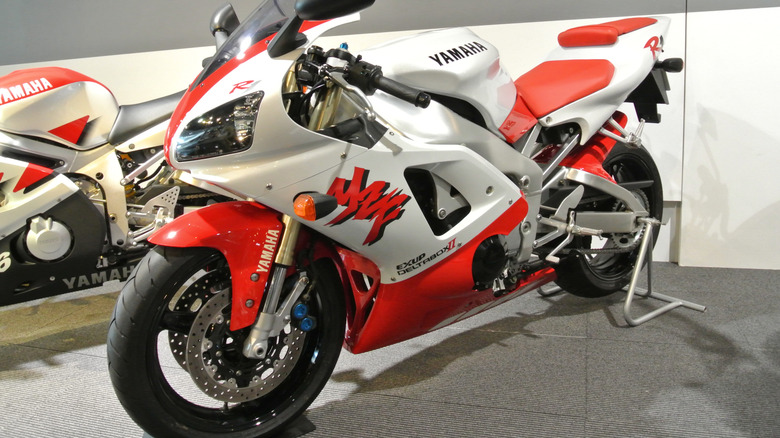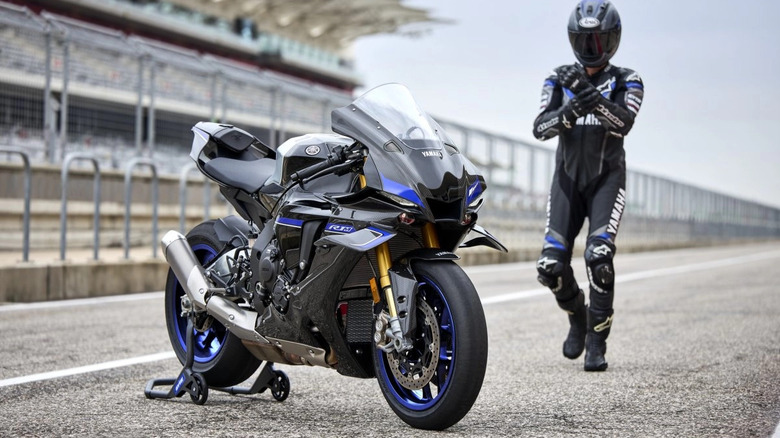How The Yamaha YZF-R1 Changed Sports Bikes Forever
In the '90s, Japan's "big four" (Honda, Kawasaki, Suzuki, and Yamaha) clashed for superbike supremacy, making some of the fastest and wildest superbikes the world had ever seen. Launched in 1998, the Yamaha YZF-R1 was Yamaha's answer to the 1-liter supersports category, and successor to the FZR-1000. Yamaha's bike competed against heavyweights like the Kawasaki ZX-9R, Suzuki GSX-750R, and the segment leader of the track, the Honda CB900RR Fireblade.
Over its 27-year production run, the Yamaha YZF-R1 has seen several major updates. In 2003 (RN09), it gained fuel injection and revised EXUP for smoother power delivery. A year later, the 2004 R1 (RN12) was fully redesigned with a new frame, upgraded brakes, and a chip-controlled throttle pushing output to 172 horsepower. In 2009, the R1 (RN22) adopted MotoGP tech with a 270-degree crossplane crankshaft engine, giving it a distinctive sound and improved delivery. By 2015, the R1 (RN32) pushed the MotoGP link further with a 200 horsepower engine and a full electronic suite including slide, launch, and slip control, plus a 6-axis IMU.
Naturally, the current R1 (RN65) is the most advanced, featuring changes to the engine for more refinement, updated electronics, improved suspension tuning, and aerodynamic bodywork inspired by the MotoGP YZR-M1. Additionally, the new R1 is also offered in a more track-focused R1M variant featuring electronically adjustable suspension. However, with its red and white paint scheme, the first generation (RN01) is considered the most iconic of all the R1 generations. At the same time, the R1, with all its updates, stands out as one of the prettiest motorcycles to come out of Japan, defined by its twin swooping headlights, sharp flowing lines, and a curvy yet sleek tail.
What made the R1 so special?
The brainchild of Kunihiko Miwa, the R1 took Honda's light is right design philosophy, which made some of the lightest and sportiest bikes and cars to the next level. At launch, it was the lightest and most powerful machine in its class. Powered by a 999cc inline-four, the first-gen R1 produced 150 horsepower and 79 pound-feet of torque, and it could achieve a top speed of 168 mph. Thanks to extensive weight-saving measures like the compact chassis design, it tipped the scales at just 435 pounds from the factory.
The R1 also introduced an industry-first vertically stacked gearbox, which made the powertrain more compact and lighter. This packaging freed up space for a longer swingarm within the sportbike's tight wheelbase, giving the bike incredible traction. The result was a machine that dethroned the Honda CBR900RR Fireblade as the most agile and desirable sports bike of its time.
It set a new standard for other bikes. With the subsequent updates, the R1 transformed into a more refined machine compared to the original, which came without any driving aids. Newer R1 versions, however, are well-known for their versatility; the R1 could adapt to different riding styles, whether aggressive or smooth. It isn't just brutally fast; it is controllable, making it a superbike that appeals to a wide range of riders. This is why it remains one of the most popular bikes in the 1-liter segment.

